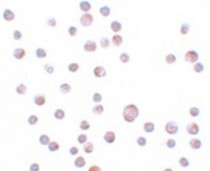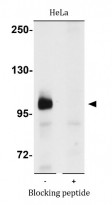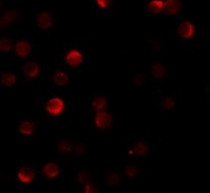ARG43425
anti-ZC3HAV1 / ZAP antibody
anti-ZC3HAV1 / ZAP antibody for ICC/IF,Western blot and Human
概述
| 产品描述 | Rabbit Polyclonal antibody recognizes ZC3HAV1 / ZAP |
|---|---|
| 反应物种 | Hu |
| 应用 | ICC/IF, WB |
| 宿主 | Rabbit |
| 克隆 | Polyclonal |
| 同位型 | IgG |
| 靶点名称 | ZC3HAV1 / ZAP |
| 抗原物种 | Human |
| 抗原 | A 14-amino acid synthetic peptide within aa. 680-730 of Human ZC3HAV1 / ZAP. |
| 偶联标记 | Un-conjugated |
| 別名 | Zinc finger CCCH-type antiviral protein 1; ADP-ribosyltransferase diphtheria toxin-like 13; ZC3H2; PARP13; ARTD13; ZC3HDC2; FLB6421; Zinc finger CCCH domain-containing protein 2; Zinc finger antiviral protein; ZAP |
应用说明
| 应用建议 |
|
||||||
|---|---|---|---|---|---|---|---|
| 应用说明 | * The dilutions indicate recommended starting dilutions and the optimal dilutions or concentrations should be determined by the scientist. | ||||||
| 阳性对照 | HeLa | ||||||
| 实际分子量 | ~ 100 kDa |
属性
| 形式 | Liquid |
|---|---|
| 纯化 | Affinity purification with immunogen. |
| 缓冲液 | PBS and 0.02% Sodium azide. |
| 抗菌剂 | 0.02% Sodium azide |
| 浓度 | 1 mg/ml |
| 存放说明 | For continuous use, store undiluted antibody at 2-8°C for up to a week. For long-term storage, aliquot and store at -20°C or below. Storage in frost free freezers is not recommended. Avoid repeated freeze/thaw cycles. Suggest spin the vial prior to opening. The antibody solution should be gently mixed before use. |
| 注意事项 | For laboratory research only, not for drug, diagnostic or other use. |
生物信息
| 数据库连接 |
Swiss-port # Q7Z2W4 Human Zinc finger CCCH-type antiviral protein 1 |
|---|---|
| 基因名称 | ZC3HAV1 |
| 全名 | zinc finger CCCH-type, antiviral 1 |
| 背景介绍 | This gene encodes a CCCH-type zinc finger protein that is thought to prevent infection by retroviruses. Studies of the rat homolog indicate that the protein may primarily function to inhibit viral gene expression and induce an innate immunity to viral infection. Alternative splicing occurs at this locus and two variants, each encoding distinct isoforms, are described. [provided by RefSeq, Jul 2008] |
| 生物功能 | Antiviral protein which inhibits the replication of viruses by recruiting the cellular RNA degradation machineries to degrade the viral mRNAs. Binds to a ZAP-responsive element (ZRE) present in the target viral mRNA, recruits cellular poly(A)-specific ribonuclease PARN to remove the poly(A) tail, and the 3'-5' exoribonuclease complex exosome to degrade the RNA body from the 3'-end. It also recruits the decapping complex DCP1-DCP2 through RNA helicase p72 (DDX17) to remove the cap structure of the viral mRNA to initiate its degradation from the 5'-end. Its target viruses belong to families which include retroviridae: human immunodeficiency virus type 1 (HIV-1), moloney and murine leukemia virus (MoMLV) and xenotropic MuLV-related virus (XMRV), filoviridae: ebola virus (EBOV) and marburg virus (MARV), togaviridae: sindbis virus (SINV) and Ross river virus (RRV). Specifically targets the multiply spliced but not unspliced or singly spliced HIV-1 mRNAs for degradation. Isoform 1 is a more potent viral inhibitor than isoform 2. Isoform 2 acts as a positive regulator of DDX58/RIG-I signaling resulting in activation of the downstream effector IRF3 leading to the expression of type I IFNs and IFN stimulated genes (ISGs). [UniProt] |
| 细胞定位 | Isoform 1: Cytoplasm. Nucleus. Note=Localizes in the cytoplasm at steady state, but shuttles between nucleus and cytoplasm in a XPO1-dependent manner. Isoform 2: Cytoplasm. [UniProt] |
| 预测分子量 | 101 kDa |
| 翻译后修饰 | Phosphorylation at Ser-275 is essential for sequential phosphorylation of Ser-271, Ser-267, Ser-263 and Ser-257 by GSK3-beta. Phosphorylation by GSK3-beta enhances its antiviral activity (By similarity). [UniProt] |
检测图片 (3) Click the Picture to Zoom In
-
ARG43425 anti-ZC3HAV1 / ZAP antibody ICC image
Immunocytochemistry: HeLa cells stained with ARG43425 anti-ZC3HAV1 / ZAP antibody at 20 µg/ml dilution.
-
ARG43425 anti-ZC3HAV1 / ZAP antibody WB image
Western blot: HeLa cell lysate stained with ARG43425 anti-ZC3HAV1 / ZAP antibody at 1 µg/ml dilution, in the absence (left) and the presence of blocking peptide (right).
-
ARG43425 anti-ZC3HAV1 / ZAP antibody ICC/IF image
Immunofluorescence: HeLa cells stained with ARG43425 anti-ZC3HAV1 / ZAP antibody at 20 µg/ml dilution.








